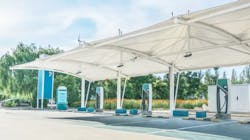Key takeaways
- Synop.ai offers software that integrates electric vehicles, chargers, and the grid, enabling efficient power allocation and infrastructure sharing among fleets and the general public.
- The company tackles U.S. charging infrastructure challenges by optimizing existing resources to reduce grid strain and increase charger availability.
- Synop promotes a collaborative approach where fleet depots serve both their needs and the general public, enhancing access to charging while minimizing new infrastructure investments.
Fleets using Synop.ai’s technology are able to allocate power based on demand and open up their depots for general use.
One of the biggest challenges to widespread electrification in the United States has undoubtedly been a lack of infrastructure. While in some states, like California, charging cords are quickly outnumbering gas nozzles, in others, running out of charge can be a very real fear.
But the obvious solution, building more chargers, comes with its challenges. America’s grid is already aging, and adding too much too quickly to its load could come with dire consequences. That’s not to mention the average time to build a charger varies depending on local regulations.
That’s where Synop comes in. Using its fleet management software, companies can not only distribute power as and where needed but also open their depots to other fleets and even the general public. Synop’s CEO Gagan Dhillon explains his company’s goals and what a “sharing economy” really means.
The following Q&A has been edited for clarity and length:
FleetOwner: What is Synop’s business?
Gagan Dhillon: We are a software company focused on building the next generation of fleet management by creating free management tools for electric fleets. These tools combine vehicles, chargers, and a grid into one place. [We are] headquartered in Brooklyn, New York, with offices in Raleigh, North Carolina, and a small team in San Francisco as well.
FO: What inspired you to start this company?
GD: First and foremost, a desire to build something. But more importantly, build something in a meaningful space. Reducing carbon emissions is an extremely meaningful and important thing that has to happen in the world as we move forward.
Every fleet is going through an electrification journey. I believed there was a need for a tool to help individuals navigate that journey. I didn't think those tools existed, and if you can help fleets to electrify, you can make a pretty substantial dent in CO2 emissions across the globe. That's what we aim to do.
FO: How does your business work? Is your software for fleet management or the chargers?
GD: Both. It's in fleet management and the chargers themselves. We control the chargers, and we get access to data from the vehicles. We don’t manufacture chargers, either. We work with about 30 different charging manufacturers to support their hardware and about 20 different types of vehicle manufacturers.
FO: Can you explain “sharing economy?”
GD: I think it's definitely something newer, the idea of a company building large infrastructure sites to use them for their purposes. But then they’re going to open them up and monetize them for other depots, so they don't have to go out and make this capital expenditure themselves.
Our customers are building charging depots for their use and then also opening them up to other fleets; for example, if there is a massive shipping company building out their depots and opening them up to Pepsi as well as FedEx or others to be able to come in and charge and utilize that infrastructure. That's one aspect of it.
The other aspect is that these depots are now becoming more accessible to the general public. The benefit of this long-term is that there's less infrastructure that has to be installed and more and more availability of charging. That's what we think about when we think about the sharing economy and charging.
See also: Are artificial safety nets setting you up for a fall?
FO: When building Synop, did you see that there was a space in the market?
GD: I don't think we can take full credit for this idea, but we certainly saw the need. Utilities lack the power to allocate to these things, nor can they allocate a significant amount of power. You have to figure out a way to meet the demand of electric vehicles across the industry, so that's where this really came from.
FO: How does this affect the grid?
GD: The effects are twofold. The first way: It's less strain on the grid. Obviously, the more infrastructure you have to build, the more power you need. So that less infrastructure means less strain on the grid because it's fewer chargers.
Number two: allocating and distributing power across a single site in a meaningful way. We have a site in Los Angeles outside of LAX. It has about 96 chargers, and we receive signals from the utility to determine when we can use maximum power and when we cannot, as we need to allocate resources based on the cost of energy.
Having those signals in real time helps reduce demand and strain on the grid, as the power can be assigned elsewhere.
FO: Do you think it might end up being that larger companies realize there's a lot of money to be made from sharing their chargers and that inspires them to build more depots?
GD: I think that’s probably not the answer. The allocation and management of power across depots is the answer. Building more over time is probably good, but managing the power that's available and the capacity that the American grid has is way more important because it really has much more significant things to power, like hospitals and other critical infrastructure. And if you're introducing this new complexity of power that is required for electric vehicles, you have to figure out where to balance that into other critical infrastructure.
FO: Does every depot with your technology take advantage of the sharing ecosystem?
GD: Most of them choose to, but the market is still very early.
FO: Is Synop the only one with this kind of setup, or are there competitors?
GD: There are always competitors, right? I think what makes us unique is we can run depots completely off the grid. We have access to battery storage and solar. On certain sites, we don't even need a connection to the grid.
I think the other differentiator here is that, really, everyone uses the word “AI.” I'm not going to use it, but I'm going to use the word automation. We have built a lot of automation in how we manage to allocate power across depots, and how you can make sure that the signals you receive are not in any way interfering with what's going on with the broader power.
FO: Do you anticipate having a connected network across the U.S. in the next 15-20 years?
GD: Absolutely. We have a map of the ones that'll come online across North America by 2028; half of them are under construction right now. It'll be 5,000 chargers in total, and we manage 5,000 already. That's the start of the plan.
About the Author

Jennifer Ramsay
Jennifer Ramsay is an editor-at-large at Endeavor Business Media. In her role, Ramsay is responsible for curating several of the Market Moves newsletters and keeping tabs on the latest in the world of electric vehicles and clean energy.
